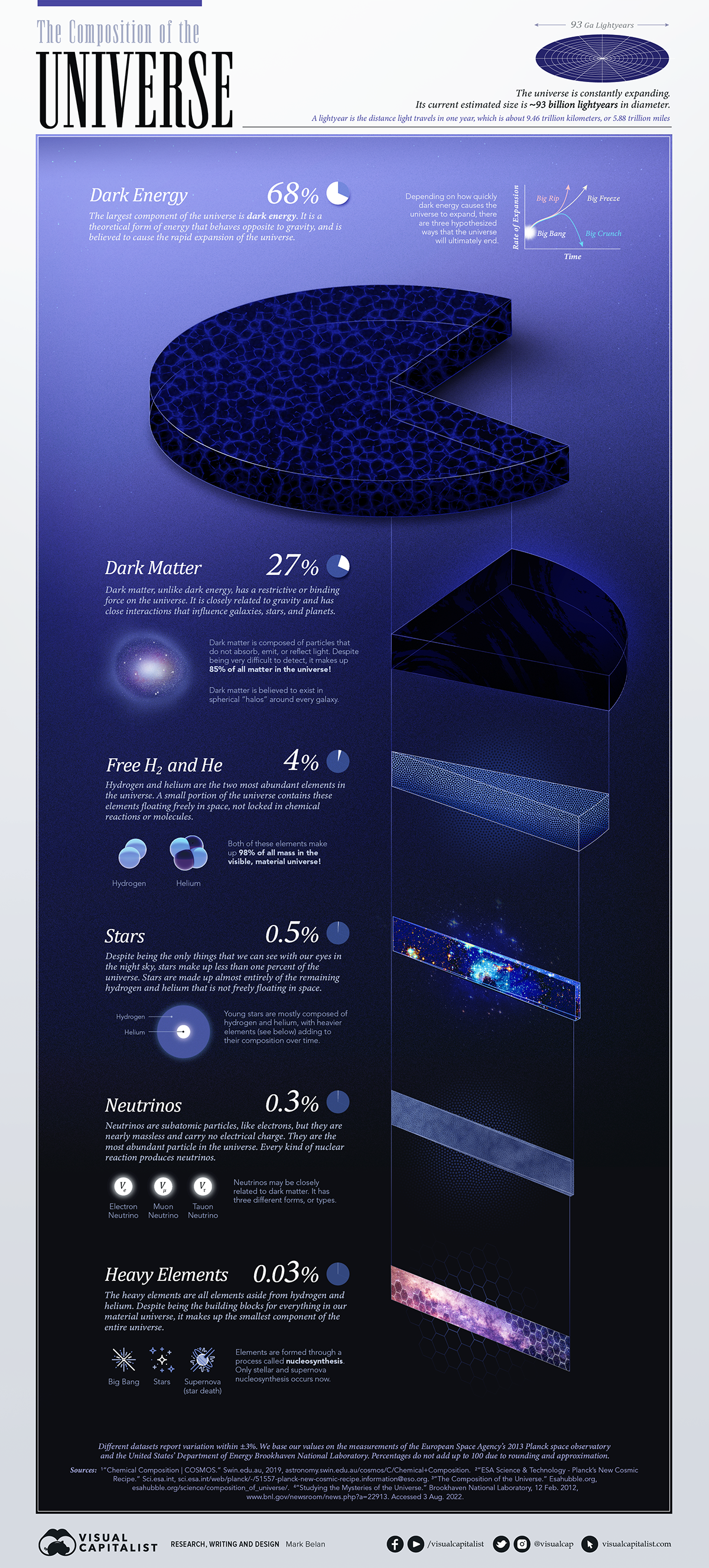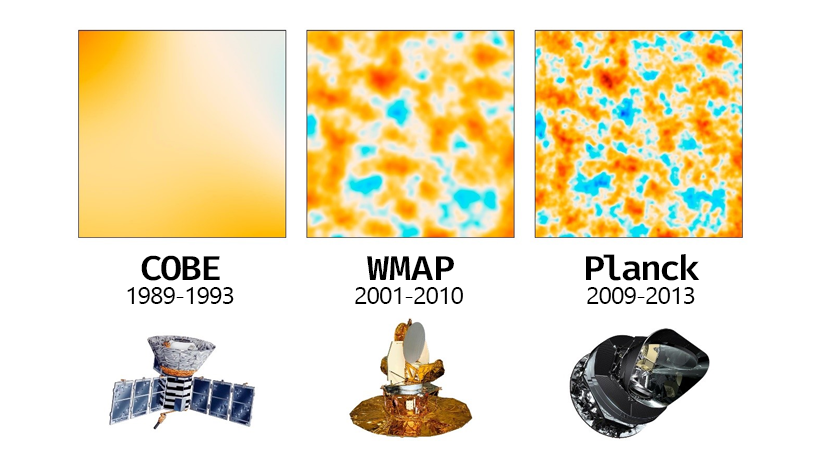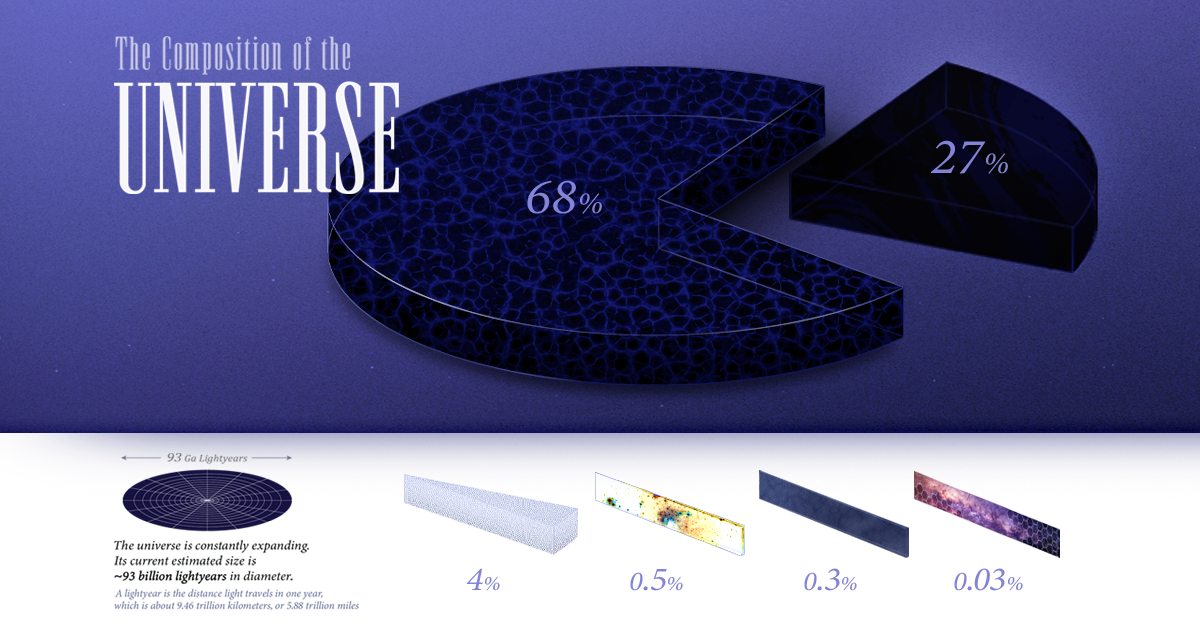Education
All the Contents of the Universe, in One Graphic

All the Contents of the Universe, in One Graphic
Scientists agree that the universe consists of three distinct parts: everyday visible (or measurable) matter, and two theoretical components called dark matter and dark energy.
These last two are theoretical because they have yet to be directly measured—but even without a full understanding of these mysterious pieces to the puzzle, scientists can infer that the universe’s composition can be broken down as follows:
| Component | Value | ||||
|---|---|---|---|---|---|
| Dark energy | 68% | ||||
| Dark matter | 27% | ||||
| Free hydrogen and helium | 4% | ||||
| Stars | 0.5% | ||||
| Neutrinos | 0.3% | ||||
| Heavy elements | 0.03% |
Let’s look at each component in more detail.
Dark Energy
Dark energy is the theoretical substance that counteracts gravity and causes the rapid expansion of the universe. It is the largest part of the universe’s composition, permeating every corner of the cosmos and dictating how it behaves and how it will eventually end.
Dark Matter
Dark matter, on the other hand, has a restrictive force that works closely alongside gravity. It is a sort of “cosmic cement” responsible for holding the universe together. Despite avoiding direct measurement and remaining a mystery, scientists believe it makes up the second largest component of the universe.
Free Hydrogen and Helium
Free hydrogen and helium are elements that are free-floating in space. Despite being the lightest and most abundant elements in the universe, they make up roughly 4% of its total composition.
Stars, Neutrinos, and Heavy Elements
All other hydrogen and helium particles that are not free-floating in space exist in stars.
Stars are one of the most populous things we can see when we look up at the night sky, but they make up less than one percent—roughly 0.5%—of the cosmos.
Neutrinos are subatomic particles that are similar to electrons, but they are nearly weightless and carry no electrical charge. Although they erupt out of every nuclear reaction, they account for roughly 0.3% of the universe.
Heavy elements are all other elements aside from hydrogen and helium.
Elements form in a process called nucleosynthesis, which takes places within stars throughout their lifetimes and during their explosive deaths. Almost everything we see in our material universe is made up of these heavy elements, yet they make up the smallest portion of the universe: a measly 0.03%.
How Do We Measure the Universe?
In 2009, the European Space Agency (ESA) launched a space observatory called Planck to study the properties of the universe as a whole.
Its main task was to measure the afterglow of the explosive Big Bang that originated the universe 13.8 billion years ago. This afterglow is a special type of radiation called cosmic microwave background radiation (CMBR).
Temperature can tell scientists much about what exists in outer space. When investigating the “microwave sky”, researchers look for fluctuations (called anisotropy) in the temperature of CMBR. Instruments like Planck help reveal the extent of irregularities in CMBR’s temperature, and inform us of different components that make up the universe.
You can see below how the clarity of CMBR changes over time with multiple space missions and more sophisticated instrumentation.

What Else is Out There?
Scientists are still working to understand the properties that make up dark energy and dark matter.
NASA is currently planning a 2027 launch of the Nancy Grace Roman Space Telescope, an infrared telescope that will hopefully help us in measuring the effects of dark energy and dark matter for the first time.
As for what’s beyond the universe? Scientists aren’t sure.
There are hypotheses that there may be a larger “super universe” that contains us, or we may be a part of one “island” universe set apart from other island multiverses. Unfortunately we aren’t able to measure anything that far yet. Unravelling the mysteries of the deep cosmos, at least for now, remains a local endeavor.
Misc
Which U.S. College Major is the Worst for Finding a Job?
In a rapidly changing economy, some skill sets are losing their sheen. Here are the worst college majors for finding a job.

Which U.S. College Major is the Worst for Finding a Job?
This was originally posted on our Voronoi app. Download the app for free on Apple or Android and discover incredible data-driven charts from a variety of trusted sources.
Finding a job can often be a Sisyphean task in this rapidly changing modern economy. Highly sought after skills come and go, following the greater tides of technology change, marketplace behavior, and shifting consumer patterns.
After all, take a look at what’s happening in the tech world.
Education plays an important role in this job hunting business of course. And some skill sets are losing their sheen, with their practitioners having a harder time than others in securing gainful employment.
But which ones are the worst right now?
We visualize the top 10 U.S. college majors, ranked by their unemployment rate, including their underemployment rate for additional context. These figures are of recent college graduates (those aged 22–27 with a bachelor’s degree or higher) and are sourced from the New York Federal Reserve, current up to February 2024.
Ranked: U.S. Majors with the Highest Unemployment Rates
Heading the first three spots on this list are all the majors with “art” in their name.
Nearly 8% of recent Art History, Liberal Arts, and Fine Arts graduates are unemployed, with more than 50% of them underemployed.
| Rank | U.S. Major | Unemployment Rate | Underemployment Rate |
|---|---|---|---|
| 1 | 🎨 Art History | 8.0% | 62.3% |
| 2 | 📘 Liberal Arts | 7.9% | 56.7% |
| 3 | 🖌️ Fine Arts | 7.9% | 55.5% |
| 4 | 🚀 Aerospace Engineering | 7.8% | 17.9% |
| 5 | 📜 History | 7.5% | 53.5% |
| 6 | 📚 English Language | 6.6% | 48.4% |
| 7 | 📺 Mass Media | 6.3% | 47.7% |
| 8 | 🔬 Physics | 6.2% | 31.2% |
| 9 | 🎨 Commercial Art & Graphic Design | 6.0% | 33.7% |
| 10 | 👥 Sociology | 5.5% | 49.6% |
| N/A | 📉 Average Rate | 3.5% | 40.3% |
At fourth place, 7.8% of recent Aerospace Engineering majors have not found a job—a surprising statistic since engineering is regarded as one of the more stable majors to study.
In fact from same data source, Industrial and Mechanical engineers have some of the lowest unemployment rates in the country.
However, aerospace engineering jobs tend to be clustered around the big companies in an otherwise small industry, with additional requirements for security clearances. Tellingly, the underemployment rate for aerospace engineering graduates is less than 20%, which is the best out of this list.
At fifth, sixth, and seventh place are History (7.5%), English (6.6%), and Mass Media (6.3%) of which the former two have also seen a rapid decline in undergraduates in the last decade.
-

 Technology2 weeks ago
Technology2 weeks agoRanked: The Most Popular Smartphone Brands in the U.S.
-

 Automotive1 week ago
Automotive1 week agoAlmost Every EV Stock is Down After Q1 2024
-

 Money1 week ago
Money1 week agoWhere Does One U.S. Tax Dollar Go?
-

 Green2 weeks ago
Green2 weeks agoRanked: Top Countries by Total Forest Loss Since 2001
-

 Real Estate2 weeks ago
Real Estate2 weeks agoVisualizing America’s Shortage of Affordable Homes
-

 Maps2 weeks ago
Maps2 weeks agoMapped: Average Wages Across Europe
-

 Mining2 weeks ago
Mining2 weeks agoCharted: The Value Gap Between the Gold Price and Gold Miners
-

 Demographics2 weeks ago
Demographics2 weeks agoVisualizing the Size of the Global Senior Population


















